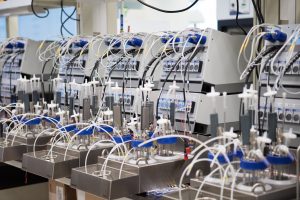
Bioreactors (Copyright CCRM 2017)
The recent FDA approvals of Kymriah™ for the treatment of children and young adults with B-cell Acute Lymphoblastic Leukemia, and Yescarta™ to treat adults with certain types of non-Hodgkin lymphoma, and the unanimous endorsement by an FDA advisory committee of a gene therapy (LUXTURNA™) has energized the fields of cell-and gene-based therapies. (Learn how gene therapies work, here.) The requirement to manufacture millions of doses of cell- and gene-based therapies no longer seems an academic exercise based on theoretical case studies, but a new reality. As with any emergent field, a number of processing and analytical challenges must be systematically addressed to enable the transformative potential of cell- and gene-based therapies.
Importantly, due to the plethora of individualized, customized methods to isolate, expand, process and cryopreserve cells there has been little consensus, harmonization or standards in the field of bioprocessing and analyzing cell or gene therapy products (CTP/GTPs). The net effect has been a multitude of data that are often not privy to comparisons due to a high degree of variability between protocols, processes and analytical methods. The inability to compare, learn from negative results and harmonize findings needs to be systematically addressed to ensure consistent progress in the field to realize its full potential.
A systematic and academic-research based approach to investigate and evaluate the challenges facing successful development and implementation of CTPs/GTPs would thus be timely. Using an industrial approach to quantify the effects of bioprocessing parameters, especially on cell identity and potency, would provide a much needed set of analytical tools to advance the field. Standardization and harmonization of measurement attributes to evaluate bioprocess parameters, and quality attributes of CTP/GTPs will provide a common lexicon for sponsors and regulators alike in evaluating their products.
Under a new monthly feature that I will lead, invited guest writers will speak to specific bioprocess and bioanalytical challenges, and proposed solutions in the development of their CTPs/GTPs. The main objective is to create a Canadian-led ecosystem on a unified and emerging theme on core bioprocess and bioanalytical functions that can be broadly applied to different CTPs/GTPS.
Specific topics will include tools to query and develop the design space for various CTP/GTPs, identifying and controlling critical process parameters (CPP). The design space relationships between CPP variables affecting critical quality attributes (CQAs) will be unique for each CTP whether autologous CAR-Ts, allogeneic MSCs, universal donor lines of iPSC-derived cells, etc. However, common principles may be applied, and features of the creation, testing and analyses of the design space may be exported between CTPs.
Equally important will be identifying and understanding the CQAs and their relationship and sensitivity to process parameters. Developing analytical methods with common read-outs and consensus on the use of those analytical methods will be important. In this area, great progress is being made by the International Standards Organization, American Society for Testing and Materials (ASTM) and a newly formed Standards Coordinating Body that has partnered with Nexight Group, a consulting firm that recently received the FDA contract for developing standards in the regenerative medicine space.
There is also significant international work underway to develop physical reference materials for analytical methods to characterize CQAs of CTP/GPT. Standard bodies such as the UK’s National Institute of Biological Standards and Control, and the U.S.’s National Institute of Standards and Technology are leading the charge and guest writers will speak to these initiatives.
Switching to more rapid or sensitive analytical methods that ultimately result in cost savings and/or improve product quality and safety profiles still requires overcoming a hurdle in terms of validating such methods in compliance with regulatory guidelines. Understanding the regulatory frameworks can help in developing risk-based strategies to validate analytical methods that address all compliance issues without going overboard. Guest writers will blog about their experiences in adopting new analytical methods to more effectively characterize CTP/GTPs.
Overall, this monthly feature will speak to advances in manufacturing and bioprocessing technologies, development of novel bioanalytical techniques, strategies for validating bioprocess changes and new analytical methods. I hope it will provide a crucial regulatory-guided perspective to meaningfully implement process and/or analytical changes. I look forward to your comments regarding this post and future ones on this theme.
Sowmya Viswanathan
Latest posts by Sowmya Viswanathan (see all)
- Raman spectroscopy for monitoring therapeutic cell manufacturing – Part 2 - March 28, 2019
- Without new funding, key part of Canada’s stem cell research ecosystem to close - February 28, 2019
- Raman spectroscopy for monitoring therapeutic cell manufacturing – Part 1 - September 6, 2018






Hello Dr. Viswanathan,
Thank you for this blog, and I look forward to future posts on the bioanalytical challenges of gene therapy products.
While my company is currently not involved in gene therapy research, we have aspirations in that area. I recall a presentation from Bluebird earlier in 2017 outlining the scope of the problem, and am looking for sources of ‘best practices’ information, such as I have been used to regarding ligand binding assays.
Wishing you a successful 2018,
Tom